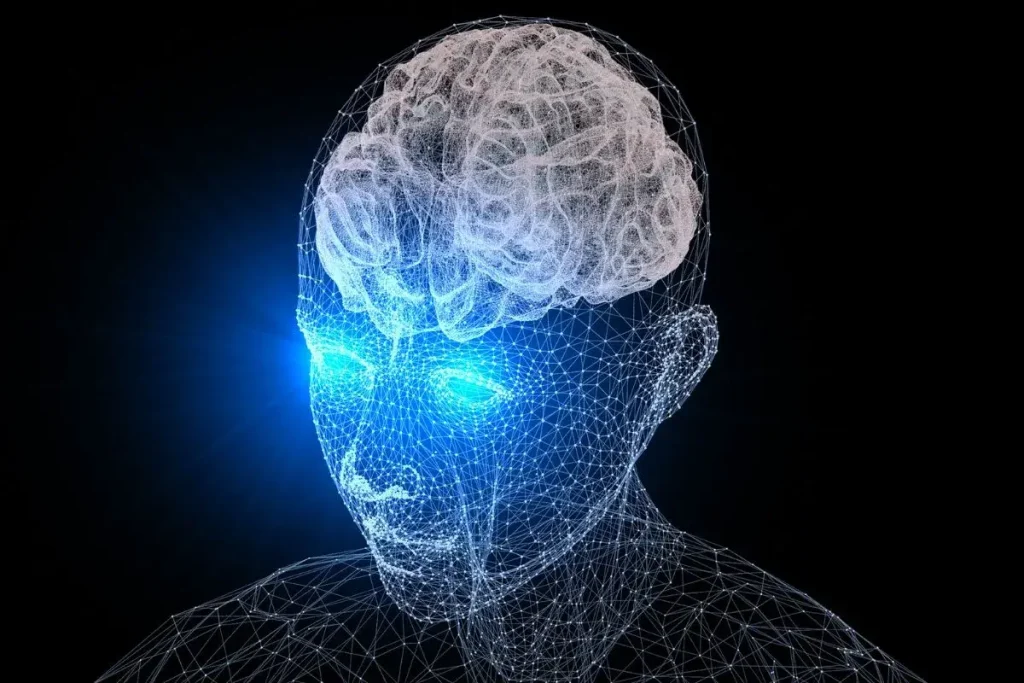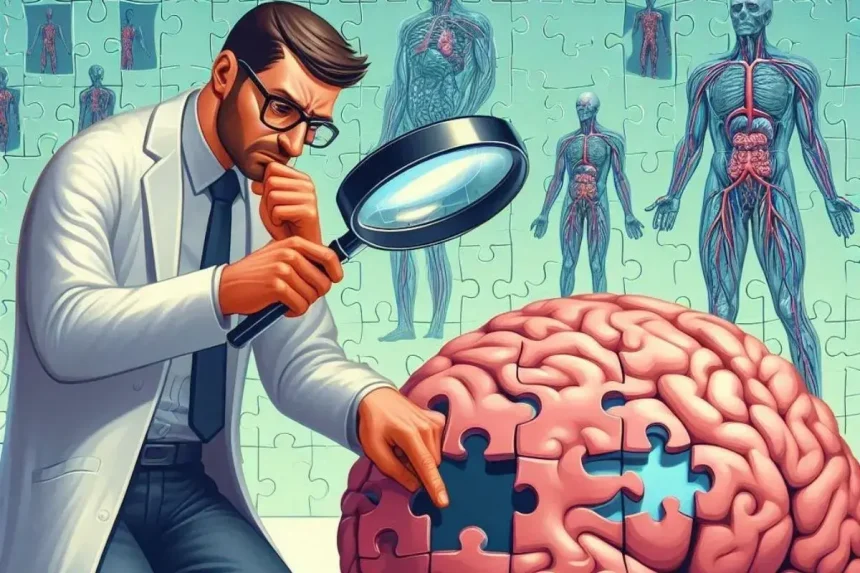Understanding the mind is a complex journey. The mind influences how we think, feel, and act. But where exactly is the mind situated? This question has puzzled scientists and philosophers for centuries. In this blog, we will explore various theories and perspectives on where the mind is located.
The Brain: The Center of the Mind
The Role of the Brain
The brain is often considered the central hub of the mind. It controls our thoughts, emotions, and actions. Neurons in the brain communicate through electrical signals, creating our experiences.
Key Points
- Neurons: They transmit information in the brain.
- Cerebral Cortex: Responsible for higher-order functions like thinking and decision-making.
- Limbic System: Controls emotions and memory.
Brain Regions and Their Functions
Different parts of the brain have specific roles. For example, the frontal lobe is crucial for problem-solving and planning. The temporal lobe processes auditory information and is key for memory.
Brain Regions
- Frontal Lobe: Thinking, planning, problem-solving.
- Temporal Lobe: Hearing, memory, speech.
- Parietal Lobe: Sensory information, spatial awareness.
- Occipital Lobe: Visual processing.
The Body-Mind Connection
The Nervous System
The nervous system extends throughout the body. It connects the brain to the spinal cord and nerves. This system allows the brain to communicate with the rest of the body.
Key Points
- Central Nervous System (CNS): Includes the brain and spinal cord.
- Peripheral Nervous System (PNS): Consists of nerves that connect the CNS to the rest of the body.
Embodied Cognition
Embodied cognition is a theory that the mind is not just in the brain. It suggests that the body influences the mind. Our physical interactions with the world shape our thoughts and emotions.
Examples
- Gestures: Using hand movements can help thinking.
- Posture: Standing tall can improve confidence.
Philosophical Perspectives

Dualism
Dualism is the idea that the mind and body are separate. René Descartes, a famous philosopher, proposed this theory. He believed the mind exists independently of the brain.
Key Points
- Mind-Body Separation: The mind is non-physical, while the body is physical.
- Consciousness: Exists independently of the physical brain.
Monism
Monism is the belief that the mind and body are one. Everything, including thoughts and feelings, arises from physical processes in the brain.
Types of Monism
- Physicalism: Only physical things exist. The mind is a result of brain activity.
- Idealism: Only mental things exist. Physical objects are just ideas in our minds.
Modern Theories
The Integrated Information Theory (IIT)
IIT suggests that consciousness arises from integrated information. It proposes that the more integrated and interconnected the brain’s information, the higher the level of consciousness.
Key Points
- Consciousness: Linked to how information is integrated in the brain.
- Phi (Φ): A measure of integrated information.
The Global Workspace Theory (GWT)
GWT posits that the mind is like a theater. Information comes into the “spotlight” of awareness, and the rest stays in the “backstage” of the unconscious.
Key Points
- Consciousness: Involves broadcasting information to different brain areas.
- Working Memory: The “workspace” where conscious processing happens.
The Mind in Different Cultures
Eastern Philosophies
Eastern philosophies often view the mind and body as interconnected. In Hinduism and Buddhism, the mind is not confined to the brain. It is seen as part of a larger consciousness that pervades the universe.
Key Points
- Meditation: Practices to connect mind and body.
- Chakras: Energy centers in the body influencing the mind.
Western Views
Western views traditionally emphasize the brain’s role in the mind. However, there is growing recognition of the mind-body connection and the influence of physical health on mental well-being.
Key Points
- Psychotherapy: Treats mental disorders by addressing thoughts and emotions.
- Mindfulness: Practices to improve mental health by focusing on the present moment.
The Mind and Technology

Artificial Intelligence (AI)
AI research aims to create machines that mimic human thought. Understanding how the mind works helps develop more advanced AI systems.
Key Points
- Machine Learning: AI systems that learn from data.
- Neural Networks: AI models inspired by the human brain’s structure.
Virtual Reality (VR)
VR technology explores how altering perceptions can change the mind. VR can simulate experiences, affecting how we think and feel.
Key Points
- Immersive Experiences: VR creates realistic simulations.
- Therapeutic Uses: VR is used in treating phobias and PTSD.
The mind’s location is a complex and intriguing topic. While the brain is central to our understanding, the body and environment also play crucial roles. Philosophical, cultural, and technological perspectives offer diverse insights. Understanding the mind’s situatedness helps us appreciate the intricate web of factors that shape our thoughts and experiences.
References
- Harvard Medical School: Understanding the Brain
- Stanford Encyclopedia of Philosophy: Dualism
- MIT Press: Global Workspace Theory
- MIT GWT
Main Points of Philosophy of Mind
The philosophy of mind is a branch of philosophy that studies the nature of the mind, mental events, mental functions, consciousness, and their relationship to the physical body, particularly the brain. Here are the main points and concepts commonly discussed in this field:
1. Dualism
Dualism is the belief that the mind and body are distinct and separate entities.
- Key Proponent: René Descartes.
- Types:
- Substance Dualism: The mind and body are composed of different substances.
- Property Dualism: The mind and body are composed of the same substance but have different properties.
2. Physicalism (Materialism)
Physicalism asserts that everything about the mind can be explained in physical terms.
- Types:
- Reductive Physicalism: Mental states can be reduced to physical states (e.g., brain states).
- Non-Reductive Physicalism: Mental states are not reducible but still depend on physical states.
3. Functionalism
Functionalism argues that mental states are defined by their functional roles rather than by their physical makeup.
- Key Idea: Mental states are like software states that can run on different hardware.
4. Behaviorism
Behaviorism claims that mental states are nothing more than behavioral tendencies or dispositions.
- Types:
- Methodological Behaviorism: Focuses on observable behavior.
- Radical Behaviorism: Includes internal events but still regards them as behaviors.
5. Identity Theory
Identity theory posits that mental states are identical to brain states.
- Key Idea: Each type of mental state corresponds to a specific type of brain state.
6. Panpsychism
Panpsychism suggests that consciousness is a fundamental and ubiquitous feature of the physical world.
- Key Idea: Every part of matter has some form of consciousness.
7. Emergentism
Emergentism argues that mental states emerge from complex physical systems but are not reducible to them.
- Key Idea: Mental properties emerge at higher levels of complexity.
8. Intentionality
Intentionality refers to the capacity of the mind to be directed toward or about something.
- Key Idea: Mental states are characterized by their intentional content.
9. Qualia
Qualia are the subjective, qualitative aspects of conscious experience.
- Key Idea: The ‘what it is like’ aspect of mental states, such as the redness of red.
10. Consciousness and the Hard Problem
The ‘hard problem’ of consciousness addresses why and how physical processes in the brain give rise to subjective experience.
- Key Proponent: David Chalmers.
- Key Idea: The hard problem is distinguished from ‘easy problems’ like understanding brain functions and behaviors.
Key Thinkers and Texts
- René Descartes: “Meditations on First Philosophy”
- David Chalmers: “The Conscious Mind: In Search of a Fundamental Theory”
- Daniel Dennett: “Consciousness Explained”
- Gilbert Ryle: “The Concept of Mind”
- John Searle: “The Rediscovery of the Mind”
The philosophy of mind covers various theories and debates about the nature of the mind, the relationship between mind and body, consciousness, and mental states. Understanding these concepts helps us explore fundamental questions about human experience and cognition.
References
- Stanford Encyclopedia of Philosophy: Philosophy of Mind
- Internet Encyclopedia of Philosophy: Philosophy of Mind
- Routledge Encyclopedia of Philosophy: Philosophy of Mind
Sayings About the Mind in Different Cultures
Western Culture
- “The mind is everything. What you think, you become.” – Buddha
- This quote emphasizes the power of the mind in shaping our reality. It highlights the influence of thoughts on our actions and life outcomes.
Eastern Philosophies
- “Quiet the mind, and the soul will speak.” – Ma Jaya Sati Bhagavati
- This saying underscores the importance of inner peace and mindfulness. It suggests that a calm mind allows for deeper understanding and spiritual insight.
Native American Wisdom
- “Do not be afraid to cry. It will free your mind of sorrowful thoughts.” – Hopi Proverb
- This proverb teaches the healing power of expressing emotions. It suggests that releasing pent-up feelings can clear the mind and bring peace.
African Proverbs
- “Wisdom is like a baobab tree; no one individual can embrace it.” – Akan Proverb
- This saying from Ghana highlights the collective nature of wisdom. It implies that understanding and knowledge are vast, requiring multiple perspectives and communal effort.
Islamic Teachings
- “A good deed is never lost; he who sows courtesy reaps friendship, and he who plants kindness gathers love.” – Islamic Proverb
- This emphasizes the importance of good deeds and positive thoughts. It reflects the belief that the mind’s intentions lead to beneficial outcomes in life.
Chinese Philosophy
- “The mind is not a vessel to be filled, but a fire to be kindled.” – Plutarch (often cited in Chinese contexts)
- This quote, though Greek in origin, is popular in Chinese educational philosophy. It suggests that education should inspire and ignite curiosity rather than simply impart information.
Hindu Teachings
- “As a man thinketh in his heart, so is he.” – Proverbs 23:7 (often referenced in Hindu contexts)
- This saying emphasizes the power of thoughts in determining one’s character and destiny. It aligns with the Hindu belief in the transformative power of the mind.
These sayings from different cultures highlight the universal importance of the mind in shaping our experiences, emotions, and actions. They reflect diverse perspectives on mindfulness, wisdom, and the power of thoughts.
References
- Buddha’s Teachings: Buddha’s Quotes on the Mind
- Ma Jaya Sati Bhagavati: Goodreads Quotes
- Hopi Proverb: Hopi Wisdom
- Akan Proverb: Ghanaian Proverbs
- Islamic Proverb: Islamic Teachings
- Plutarch’s Quote: Chinese Philosophy
- Hindu Teachings: Hindu Proverbs
Mind and Consciousness in Sufism

Sufism, or Tasawwuf, is the mystical branch of Islam that seeks direct personal experience with the Divine. It focuses on the inward search for God and emphasizes the purification of the mind and heart to achieve a higher state of consciousness.
The Concept of the Mind in Sufism
In Sufism, the mind is viewed as a tool that can either aid in spiritual growth or hinder it, depending on how it is used. The mind’s primary role is to help understand the divine reality and to control the lower desires (nafs).
- Nafs (Ego): The nafs is often seen as the lower self or ego that distracts the individual from God. The purification of the nafs is a central concept in Sufism. This process is known as “Tazkiyah.”
- Aql (Intellect): The intellect is considered crucial for discerning truth from falsehood and for understanding divine signs. However, it must be balanced with spiritual insight (basirah).
Consciousness in Sufism
Sufism places a strong emphasis on achieving higher states of consciousness. This involves moving beyond the material world and entering into a direct, personal relationship with the Divine. Sufis seek to transcend ordinary states of consciousness through various practices:
- Dhikr (Remembrance of God): Repeating the names of God or phrases that praise God to achieve a state of spiritual awareness and proximity to the Divine.
- Muraqaba (Meditation): A practice of focused contemplation on God to deepen one’s connection and awareness of His presence.
- Fana (Annihilation): The dissolution of the self into God, leading to a state where the individual’s consciousness is absorbed into divine consciousness.
- Baqa (Subsistence): After achieving fana, the individual reaches baqa, a state of enduring existence in and with God.
Key Concepts in Sufi Consciousness
- Ihsan (Excellence): Performing actions as if one is in the presence of God, reflecting a heightened state of mindfulness and consciousness.
- Marifa (Gnosis): Direct knowledge of God that transcends intellectual understanding, attained through inner experience and spiritual insight.
- Haqiqa (Reality): The ultimate truth that Sufis seek, representing the deeper, mystical understanding of God and the universe.
Sufi Practices for Mind and Consciousness
- Sama (Listening): Engaging in spiritual music and poetry, such as the works of Rumi, to inspire divine love and ecstasy.
- Sohbet (Spiritual Conversation): Dialogues with a spiritual guide or fellow seekers to enhance understanding and insight.
- Tawakkul (Trust in God): Surrendering one’s will to God, trusting in His wisdom and plans.
In Sufism, the mind and consciousness are seen as vehicles for achieving a deeper, more intimate connection with God. Through purification practices and spiritual exercises, Sufis aim to transcend the ego and attain a higher state of awareness that aligns with the divine reality.
References
- The Sufi Path of Love: The Spiritual Teachings of Rumi by William C. Chittick.
- Sufism: An Introduction to the Mystical Tradition of Islam by Carl W. Ernst.
- The Essential Rumi translated by Coleman Barks.
- Stanford Encyclopedia of Philosophy: Sufism – Sufism
- Encyclopaedia Britannica: Sufism – Sufism
These references provide deeper insights into the principles of mind and consciousness in Sufism, highlighting its rich and profound spiritual traditions.These resources provide a deeper understanding of the cultural context and meanings behind these profound sayings.
The Mind in Native American Philosophy
Native American philosophy offers unique and profound insights into the nature of the mind. Unlike Western perspectives that often separate the mind and body, Native American views tend to emphasize a holistic integration of mind, body, spirit, and community. Here are some key concepts and sayings that reflect these perspectives:
Holistic Integration
In many Native American cultures, the mind is not seen as an isolated entity but as deeply interconnected with the body, spirit, and the natural world. This holistic approach suggests that mental health and well-being are intrinsically linked to physical health, spiritual balance, and harmony with the environment.
- “The mind, heart, and body are one. A hurt to one is a hurt to all.”
- This saying reflects the interconnectedness of different aspects of being, emphasizing that well-being is a result of balanced integration.
The Heart-Mind Connection
In some Native American languages, there is no distinct word for “mind” as separate from the heart or spirit. For example, in many Indigenous languages, the concept of thinking is often closely linked with feeling and intuition, suggesting a more integrated approach to cognition.
- Lakota Philosophy: The Lakota people often refer to the “heart-mind” (nagi) as a unified concept where thoughts and emotions are intertwined.
- Navajo (Diné) Philosophy: The Diné people use the concept of “hozho,” which means harmony, balance, and beauty, to describe a state of mental and spiritual well-being.
The Role of Nature
Nature plays a crucial role in Native American conceptions of the mind. The natural world is seen as a source of wisdom and healing, and maintaining a connection with nature is considered essential for mental and spiritual health.
- “Listen to the wind, it talks. Listen to the silence, it speaks. Listen to your heart, it knows.” – Navajo Proverb
- This saying underscores the importance of tuning into the natural world and one’s inner self for guidance and wisdom.
The Medicine Wheel
The Medicine Wheel is a symbol used by various Native American tribes to represent the cyclical nature of life and the interconnectedness of all things. It is often used as a tool for teaching about the balance of the mind, body, spirit, and emotions.
- Medicine Wheel Teachings: Each direction of the Medicine Wheel (North, South, East, West) is associated with different aspects of life, including physical, emotional, mental, and spiritual dimensions. Balancing these aspects is seen as crucial for overall well-being.
Community and the Mind
Community and relationships are central to Native American views of the mind. Mental well-being is often seen as a communal rather than an individual responsibility, with an emphasis on the importance of family, tribe, and community support.
- “We are all related.” – Lakota Proverb (“Mitakuye Oyasin”)
- This saying expresses the belief in the interconnectedness of all beings and the idea that one’s mental and spiritual health is tied to the health of the community and the natural world.
In Native American philosophy, the mind is viewed as an integral part of a holistic system that includes the body, spirit, community, and nature. This interconnected perspective offers valuable insights into achieving mental and spiritual well-being through balance and harmony.
References
- Smithsonian National Museum of the American Indian: Healing and Well-Being in Native American Culture
- Indigenous Corporate Training Inc.: Native American Beliefs and the Medicine Wheel
- Native Voices: Native Wisdom and Teachings
These resources provide a deeper understanding of Native American perspectives on the mind and its place within the broader context of life and the universe.
The Mind in Chinese Philosophy
Chinese philosophy offers profound insights into the nature and location of the mind, integrating various schools of thought including Confucianism, Daoism, and Buddhism. These perspectives provide a holistic understanding of the mind’s relationship with the body, spirit, and the universe.
Confucianism
Confucian philosophy emphasizes the cultivation of the mind through ethical behavior and social harmony. Confucius and his followers believed that the mind is central to achieving moral virtue and social order.
- Xin (Heart-Mind): In Confucianism, the term “xin” (心) refers to both the heart and mind, reflecting the inseparable nature of emotions and rational thought. The cultivation of “xin” involves developing moral virtues such as ren (benevolence), yi (righteousness), and li (propriety).
- Confucius Quote: “The mind of the superior man is conversant with righteousness; the mind of the mean man is conversant with gain.” (Analects 4:16)
Daoism (Taoism)
Daoism, founded by Laozi, presents a more mystical view of the mind. It emphasizes harmony with the Dao (the Way) and the natural world.
- Wu Wei (Non-Action): Daoism advocates for “wu wei,” or effortless action, which involves aligning one’s mind with the natural flow of the universe. This state allows for spontaneous and harmonious living without forced effort.
- Laozi Quote: “The sage is wise because he understands his mind and practices non-action.” (Dao De Jing, Chapter 48)
- Shen (Spirit): In Daoism, the mind is also associated with “shen” (spirit), which resides in the heart. Cultivating the spirit involves practices like meditation, breath control, and exercises such as Tai Chi and Qigong to harmonize the mind and body.
Buddhism
Chinese Buddhism integrates Indian Buddhist concepts with traditional Chinese thought, offering a unique perspective on the mind and consciousness.
- Mindfulness and Meditation: Buddhism emphasizes the practice of mindfulness and meditation to cultivate an understanding of the mind and achieve enlightenment. The mind is seen as the source of both suffering and liberation.
- Buddha Quote: “The mind is everything. What you think, you become.”
- Alaya-Vijnana (Storehouse Consciousness): This concept from the Yogacara school of Buddhism describes a deep level of consciousness that stores all experiences and karmic seeds. It influences one’s thoughts, behaviors, and perceptions.
Integration and Harmony
Chinese philosophy often integrates these various perspectives, emphasizing the harmonious balance between the mind, body, and spirit. This holistic view is reflected in practices such as Traditional Chinese Medicine (TCM), which aims to balance the body’s energies (Qi) to promote mental and physical health.
- Traditional Chinese Medicine (TCM): In TCM, the mind is closely linked to the heart and is considered the emperor of the body’s organs. Maintaining mental health involves balancing the body’s Qi through acupuncture, herbal remedies, and lifestyle adjustments.
In Chinese philosophy, the mind is viewed as an integral part of a holistic system that includes the heart, body, spirit, and the natural world. Confucianism, Daoism, and Buddhism each offer unique insights into the nature of the mind, emphasizing ethical cultivation, harmony with the Dao, and mindfulness practices.
References
- Stanford Encyclopedia of Philosophy: Confucianism
- Dao De Jing: Dao De Jing by Laozi
- Buddhist Teaching: The Teaching of Buddha
- Traditional Chinese Medicine: TCM and Mental Health
These sources provide further exploration into the rich and diverse perspectives on the mind in Chinese philosophy.
The Mind in Japanese Philosophy

Japanese philosophy offers a rich and nuanced understanding of the mind, integrating elements from Shinto, Zen Buddhism, and indigenous Japanese thought. These perspectives emphasize harmony, interconnectedness, and the unity of mind, body, and spirit.
Zen Buddhism
Zen Buddhism, which significantly influences Japanese thought, focuses on direct experience and the practice of mindfulness and meditation to understand the nature of the mind.
- Zazen (Seated Meditation): Central to Zen practice, zazen involves sitting in meditation to quiet the mind and gain insight into its true nature. The practice aims to go beyond intellectual understanding to direct, experiential realization.
- Quote: “When the mind is at peace, the world too is at peace.” – Hakuin Ekaku, a renowned Zen master.
- Satori (Enlightenment): Satori refers to the sudden awakening or realization of the true nature of the mind and existence. It is a pivotal concept in Zen, emphasizing that enlightenment is not an intellectual achievement but a direct experience.
Shinto
Shinto, the indigenous spirituality of Japan, views the mind as interconnected with nature and the divine spirits (kami). Shinto practices emphasize purity, harmony, and the sacredness of all aspects of life.
- Kokoro (Heart-Mind): In Shinto, the concept of “kokoro” (心) represents the heart-mind, embodying the unity of emotions, thoughts, and spirit. Kokoro is seen as the seat of both mental and spiritual life, reflecting a holistic view of the individual.
- Concept: The purification rituals in Shinto, such as misogi (water purification), are believed to cleanse both the body and mind, aligning them with the divine nature of the kami.
Bushido (The Way of the Warrior)
Bushido, the ethical code of the samurai, integrates Zen and Confucian principles, focusing on discipline, honor, and mental fortitude. The mind is trained to remain calm and clear, even in the face of adversity.
- Mushin (No-Mind): Mushin refers to a state of no-mind, where the mind is free from distractions and preconceptions, allowing for spontaneous and effective action. This concept is crucial in martial arts and the samurai code.
- Quote: “The ultimate aim of martial arts is not having to use them.” – Miyamoto Musashi, a famous samurai and philosopher.
Modern Japanese Thought
Contemporary Japanese philosophy continues to explore the nature of the mind, integrating traditional concepts with modern psychological and philosophical insights.
- Naikan Therapy: Naikan is a form of introspective therapy developed in Japan that encourages individuals to reflect on their relationships and actions. It aims to cultivate a mindful and compassionate understanding of the self and others.
- Practice: Naikan involves structured reflection on three questions: What have I received from others? What have I given to others? What troubles and difficulties have I caused others?
In Japanese philosophy, the mind is seen as a unified entity encompassing emotions, thoughts, and spirit. Practices such as zazen, mushin, and Naikan therapy emphasize direct experience, mindfulness, and introspection to cultivate a deeper understanding of the mind and its connection to the world.
References
- Zen Buddhism and Meditation: Stanford Encyclopedia of Philosophy – Zen Buddhism
- Shinto and Kokoro: Encyclopaedia Britannica – Shinto
- Bushido and Mushin: Stanford Encyclopedia of Philosophy – Bushido
- Naikan Therapy: Psychology Today – Naikan Therapy
These resources provide further insights into the rich tapestry of Japanese philosophical thought and its perspectives on the mind.
The Mind in European Philosophy
European philosophy has a rich and diverse history of exploring the nature and location of the mind. From ancient Greek thinkers to contemporary philosophers, the concept of the mind has been central to understanding human consciousness, cognition, and existence.
Ancient Greek Philosophy
Plato
- Dualism: Plato viewed the mind and body as distinct entities. He believed the mind (or soul) is immortal and pre-exists before inhabiting a body.
- Theory of Forms: According to Plato, true knowledge is derived from the realm of Forms, which the mind can access through intellectual reasoning.
- Quote: “The soul, when using the body as an instrument of perception, has the power to reason about the world.”
Aristotle
- Hylomorphism: Aristotle proposed that the mind (or soul) and body are inseparable. The soul is the form of the body, and it cannot exist without it.
- Psyche: For Aristotle, the mind is the actuality of the body, functioning through faculties like nutrition, perception, and intellect.
- Quote: “The soul is the first actuality of a natural body that has life potentially.”
Medieval Philosophy
Thomas Aquinas
- Scholasticism: Aquinas integrated Aristotle’s philosophy with Christian theology. He viewed the mind as a rational soul, which is immaterial and immortal.
- Intellect and Will: Aquinas emphasized the intellect’s role in understanding universal truths and the will’s role in desiring the good.
- Quote: “The human soul, which is called the intellect or the mind, is something incorporeal and subsistent.”
Early Modern Philosophy
René Descartes
- Cartesian Dualism: Descartes famously posited that the mind and body are distinct substances. The mind is a non-material, thinking substance, while the body is a material, extended substance.
- Cogito, ergo sum: Descartes’ assertion “I think, therefore I am” emphasizes the certainty of the thinking mind’s existence.
- Quote: “The mind is a substance that is distinct from the body and can exist independently of it.”
John Locke
- Empiricism: Locke argued that the mind is a tabula rasa (blank slate) at birth, gaining knowledge through sensory experience.
- Idea Formation: The mind processes and reflects on sensory data to form ideas.
- Quote: “The mind is furnished with ideas by experience alone.”
Modern and Contemporary Philosophy
Immanuel Kant
- Transcendental Idealism: Kant proposed that the mind actively shapes experiences through innate structures and categories.
- Phenomena and Noumena: Kant distinguished between phenomena (the world as we experience it) and noumena (things-in-themselves, which are beyond our cognitive grasp).
- Quote: “The mind brings to experience certain necessary conditions of understanding.”
Sigmund Freud
- Psychoanalysis: Freud’s model of the mind includes the conscious, preconscious, and unconscious. He emphasized the influence of unconscious processes on behavior.
- Id, Ego, Superego: These three parts of the psyche interact to shape personality and behavior.
- Quote: “The mind is like an iceberg, with its bulk hidden beneath the surface.”
Maurice Merleau-Ponty
- Phenomenology: Merleau-Ponty focused on the embodied mind, arguing that perception is fundamentally tied to our bodily experience.
- Embodiment: He posited that the mind is not a detached observer but is embedded in and interacts with the world through the body.
- Quote: “The body is our general medium for having a world.”
In European philosophy, the mind has been conceptualized in various ways, from a distinct, immaterial entity to an integrated, embodied aspect of human existence. These diverse perspectives highlight the complexity and richness of philosophical inquiries into the nature of the mind.
References
- Stanford Encyclopedia of Philosophy: Plato
- Internet Encyclopedia of Philosophy: Aristotle
- Stanford Encyclopedia of Philosophy: Thomas Aquinas
- Stanford Encyclopedia of Philosophy: René Descartes
- Internet Encyclopedia of Philosophy: John Locke
- Stanford Encyclopedia of Philosophy: Immanuel Kant
- Stanford Encyclopedia of Philosophy: Sigmund Freud
- Internet Encyclopedia of Philosophy: Maurice Merleau-Ponty
These sources provide a comprehensive overview of the key ideas and philosophers in European thought regarding the nature and location of the mind.
The Mind in Aboriginal Australian and Maori (New Zealand) Philosophy
Aboriginal Australian and Maori philosophies offer profound and unique perspectives on the mind, viewing it as deeply interconnected with the body, spirit, and the natural environment. These perspectives emphasize the holistic nature of existence, where mental, physical, spiritual, and communal health are interwoven.
Aboriginal Australian Philosophy
The Concept of Mind in Aboriginal Culture
- Holistic Integration
- In Aboriginal Australian culture, the mind is not seen as a separate entity but as part of a holistic system that includes the body, spirit, and land. This interconnectedness reflects the belief that mental health and well-being are linked to the health of the community and the environment.
- Quote: “The land is the mother and we are all her children. The land is our heart and our mind.”
- Dreamtime (Tjukurrpa)
- Dreamtime, or Tjukurrpa, is a fundamental aspect of Aboriginal spirituality and cosmology. It represents the time of creation when ancestral beings shaped the world. These stories and traditions provide a framework for understanding the world and one’s place within it, guiding mental and spiritual well-being.
- Connection to Mind: The teachings and stories of Dreamtime inform the mind, offering a deep sense of identity, purpose, and belonging.
- Yarn (Storytelling)
- Storytelling, or “yarn,” is a crucial method for passing on knowledge, culture, and values. It serves as a means of connecting individuals to their heritage and to each other, fostering mental resilience and community cohesion.
Health and Well-being
- Social and Emotional Well-being (SEWB)
- Aboriginal conceptions of health encompass social and emotional well-being (SEWB), which integrates mental health with physical, spiritual, and cultural well-being. SEWB is about maintaining balance and harmony within oneself and within the community.
Maori (New Zealand) Philosophy
The Concept of Mind in Maori Culture
- Te Whare Tapa Whā Model
- Developed by Mason Durie, this model outlines a holistic view of health based on four pillars: Taha Tinana (physical health), Taha Wairua (spiritual health), Taha Hinengaro (mental health), and Taha Whānau (family health).
- Taha Hinengaro (Mental Health): Mental health is viewed in conjunction with physical, spiritual, and family health, emphasizing the interconnectedness of all aspects of well-being.
- Wairua (Spirituality)
- Wairua, or spirituality, is central to Maori health and well-being. It is believed that spiritual health significantly impacts mental health. A balanced wairua fosters a healthy mind and overall well-being.
- Mana (Authority and Prestige)
- Mana is a concept that encompasses authority, power, and spiritual force. It is intrinsically linked to one’s mental and spiritual health, as maintaining and respecting mana is crucial for personal and communal harmony.
Health and Well-being
- Whanaungatanga (Relationships)
- Whanaungatanga, or the principle of relationships and connectedness, plays a crucial role in mental health. Strong, supportive relationships within the family and community are essential for mental and emotional well-being.
- Quote: “He aha te mea nui o te ao? He tangata, he tangata, he tangata.” (What is the most important thing in the world? It is people, it is people, it is people.)
In both Aboriginal Australian and Maori philosophies, the mind is viewed as an integral part of a holistic system that includes the body, spirit, and community. These perspectives emphasize the interconnectedness of all aspects of life, highlighting the importance of balance, harmony, and relationships in maintaining mental health and well-being.
References
- Australian Indigenous HealthInfoNet: Social and Emotional Well-being
- Te Ara – The Encyclopedia of New Zealand: Maori Health
- Mason Durie’s Te Whare Tapa Whā Model: Te Whare Tapa Whā
These resources provide deeper insights into the rich and holistic perspectives on the mind in Aboriginal Australian and Maori cultures.
Where Is the Mind Situated? Perspectives from Various Religions

Different religions offer unique perspectives on the nature and location of the mind. These beliefs reflect broader spiritual and philosophical views about human consciousness, the soul, and the connection between the mind and the divine.
Islam
Concept of the Mind
- Aql (Intellect): In Islam, “aql” is the faculty of intellect and reason, given by God to humans. It is through aql that individuals discern right from wrong.
- Nafs (Self): The self, which includes desires and impulses, must be controlled and purified to attain closeness to God.
Quranic References
- Quran 17:36: “And do not pursue that of which you have no knowledge. Indeed, the hearing, the sight, and the heart – about all those [one] will be questioned.”
- Hadith: Teachings of the Prophet Muhammad emphasize the importance of seeking knowledge and wisdom.
Hinduism
Concept of the Mind
- Manas (Mind): In Hinduism, the mind is referred to as “manas,” which is considered a part of the subtle body (sukshma sharira). It functions as the intermediary between the senses and the intellect (buddhi).
- Chitta (Consciousness): The mind is also associated with “chitta,” encompassing memory and subconscious mind. The aim is to control and purify the mind through practices like yoga and meditation to achieve higher states of consciousness.
Key Texts and Concepts
- Bhagavad Gita: The Gita emphasizes the control of the mind through discipline and devotion. “For him who has conquered the mind, the mind is the best of friends; but for one who has failed to do so, his very mind will be the greatest enemy.” (Bhagavad Gita 6:6)
- Upanishads: These ancient texts explore the nature of reality and the mind’s role in realizing the self (atman) and ultimate reality (Brahman).
Buddhism
Concept of the Mind
- Citta (Mind/Heart): In Buddhism, “citta” represents both mind and heart, reflecting a unified concept of thought and emotion.
- Mindfulness and Meditation: Central practices involve observing the mind to understand its nature and to achieve enlightenment (nirvana).
Key Teachings
- Four Noble Truths: The Buddha’s teachings focus on understanding the mind’s role in suffering and liberation. The Eightfold Path includes right mindfulness and right concentration, essential for mental discipline.
- Mahayana Buddhism: Schools like Zen emphasize direct experience and the concept of the “Buddha-nature” inherent in all beings.
Christianity
Concept of the Mind
- Mind and Soul: In Christianity, the mind is often linked with the soul, and both are believed to be created by God. The mind encompasses thoughts, will, and emotions, integral to a person’s relationship with God.
Biblical References
- Romans 12:2: “Do not conform to the pattern of this world, but be transformed by the renewing of your mind.”
- Philippians 4:7: “And the peace of God, which transcends all understanding, will guard your hearts and your minds in Christ Jesus.”
Judaism
Concept of the Mind
- Yetzer Hara and Yetzer Hatov: In Jewish thought, humans possess two inclinations – yetzer hara (evil inclination) and yetzer hatov (good inclination). The mind must navigate and control these to live a righteous life.
Key Texts and Teachings
- Torah: The Torah and other Hebrew scriptures emphasize the heart and mind’s role in loving and serving God. “You shall love the Lord your God with all your heart and with all your soul and with all your might.” (Deuteronomy 6:5)
- Talmud: Rabbinic literature provides extensive discussions on ethics, law, and the mind’s role in understanding God’s commandments.
The concept of the mind varies across religions, reflecting different spiritual and philosophical understandings. While Hinduism and Buddhism emphasize meditation and mindfulness to transcend ordinary mental states, Abrahamic religions focus on the mind’s role in ethical living and spiritual growth. Despite these differences, a common thread is the belief in the mind’s significant influence on one’s spiritual journey and connection to the divine.
References
- Bhagavad Gita: Bhagavad Gita
- Upanishads: The Upanishads
- Buddhist Teachings: Buddhist Teachings
- Bible: Bible Gateway
- Quran: Quran
- Torah: Chabad Torah
These resources provide further exploration into the diverse perspectives on the mind in various religious traditions.
Where Is the Mind Situated? Perspectives from a Sheep Herder

A sheep herder, living close to nature and observing the behaviors of animals and the environment daily, may have a unique, practical, and intuitive understanding of the mind. This perspective might not be formalized in scientific terms but offers valuable insights into the mind’s nature and functions.
Practical Observations
- Mind as Part of the Whole Being
- A sheep herder might view the mind as part of the whole being, inseparable from the body and spirit. This holistic view is akin to many indigenous perspectives where mental health is deeply intertwined with physical health and environmental harmony.
- Intuition and Instinct
- Living in tune with nature, a sheep herder might emphasize intuition and instinct as critical aspects of the mind. Observing the behaviors of sheep and other animals, they might see the mind as a blend of conscious thought and instinctual response.
Connection with Nature
- Mind and Environment
- The mind, in this view, is not confined to the brain or the body but extends into the environment. The sheep herder’s sense of well-being is influenced by the land, weather, and natural cycles, suggesting a symbiotic relationship between the mind and nature.
- Example: A calm and harmonious environment may lead to a peaceful mind, while a harsh and chaotic environment could result in mental unrest.
Practical Wisdom and Stories
- Storytelling and Experience
- A sheep herder might use stories and practical experiences to explain concepts of the mind. Wisdom is often passed down through generations in the form of tales and proverbs, which reflect observations about life, nature, and human behavior.
- Attention and Presence
- The mind is seen as being present and attentive to the surroundings. The herder must be constantly aware of the flock and the environment, suggesting a state of mindfulness and presence.
- Quote: “A wandering mind is like a sheep that strays from the flock; it risks danger and must be brought back to focus.”
Metaphorical Insights
- Mind as a Shepherd
- The mind could be likened to a shepherd guiding thoughts and actions, much like the herder guides the sheep. This metaphor emphasizes the role of the mind in leading and managing one’s life.
- Example: Just as a good shepherd keeps the flock together and safe, a well-guided mind maintains coherence and well-being.
Simple Yet Profound Understanding
- Balance and Harmony
- The mind’s well-being is seen in terms of balance and harmony. A sheep herder might emphasize the importance of a balanced life, where the mind, body, and environment are in sync.
- Example: Just as sheep need balanced care (food, shelter, protection), the mind requires balanced thoughts, emotions, and actions.
From the perspective of a sheep herder, the mind is a holistic, integrated part of one’s being, closely connected to nature and governed by intuition and practical wisdom. This view emphasizes balance, harmony, and the practical management of thoughts and actions, offering a unique and grounded understanding of the mind.
References
- Indigenous Perspectives on Mind and Environment: Indigenous Knowledge Systems
- The Role of Intuition and Instinct in Human Behavior: Psychology Today – Intuition
- Mindfulness and Presence in Daily Life: Mindful.org – Mindfulness
These sources provide further insights into how practical experiences and intuitive understanding shape perspectives on the mind, much like those of a sheep herder.
Where Is the Mind Situated? Perspectives from Poets

Poets, with their unique sensitivity to language and emotion, offer profound and varied insights into the nature and location of the mind. Their reflections often blend metaphor, emotion, and philosophy, providing a rich tapestry of interpretations. Here are some key perspectives from various poets:
The Mind as a Vast Landscape
Emily Dickinson
- Metaphor of the Mind: Emily Dickinson often depicted the mind as an expansive and limitless space. In her poem “The Brain—is wider than the Sky—,” she suggests that the mind’s capacity is infinite and transcendent.
- Quote: “The Brain—is wider than the Sky— / For—put them side by side— / The one the other will contain / With ease—and You—beside—”
- Analysis: This metaphor highlights the vast potential of the mind, capable of encompassing and understanding the vastness of the universe itself.
William Wordsworth
- Nature and the Mind: Wordsworth frequently connected the mind with the natural world, seeing nature as a reflection of the inner landscape.
- Quote: “The mind that is wise mourns less for what age takes away; than what it leaves behind.”
- Analysis: Wordsworth’s poetry often explores how the mind perceives and is influenced by nature, suggesting a deep interconnection between the two.
The Mind as a Battleground
Sylvia Plath
- Inner Turmoil: Sylvia Plath’s work often delves into the darker aspects of the mind, portraying it as a site of conflict and struggle.
- Quote: “I am inhabited by a cry. Nightly it flaps out / Looking, with its hooks, for something to love.”
- Analysis: Plath’s vivid imagery captures the intensity of mental anguish and the constant search for peace and meaning within the mind.
T.S. Eliot
- Fragmented Consciousness: In “The Love Song of J. Alfred Prufrock,” T.S. Eliot illustrates the fragmented nature of modern consciousness.
- Quote: “I have measured out my life with coffee spoons.”
- Analysis: Eliot’s use of mundane imagery to describe the mind reflects a sense of disconnection and the meticulous, often overwhelming, self-examination characteristic of modern life.
The Mind as a Vessel of Imagination
William Blake
- Visionary Mind: William Blake viewed the mind as a vessel for divine vision and imagination. His works often blur the lines between reality and imagination.
- Quote: “To see a World in a Grain of Sand / And a Heaven in a Wild Flower, / Hold Infinity in the palm of your hand / And Eternity in an hour.”
- Analysis: Blake’s poetry suggests that the mind has the power to perceive the infinite and eternal within the finite and transient, emphasizing the boundless nature of imagination.
Pablo Neruda
- Sensual and Emotional Depth: Pablo Neruda’s poetry frequently explores the sensory and emotional depths of the mind.
- Quote: “I want to do with you what spring does with the cherry trees.”
- Analysis: Neruda’s vivid, sensual imagery reflects a view of the mind as deeply intertwined with physical and emotional experiences.
The Mind as a Source of Inner Peace
Rumi
- Spiritual Reflection: The Persian poet Rumi often described the mind in terms of its spiritual journey towards inner peace and divine connection.
- Quote: “The quieter you become, the more you are able to hear.”
- Analysis: Rumi’s poetry emphasizes the importance of inner stillness and reflection in achieving a deeper understanding and connection with the divine.
Walt Whitman
- Unity and Harmony: In “Leaves of Grass,” Walt Whitman celebrates the unity of the mind with the body and the universe.
- Quote: “I am large, I contain multitudes.”
- Analysis: Whitman’s expansive vision sees the mind as a harmonious part of a greater whole, capable of containing diverse experiences and identities.
Poets provide a rich and diverse array of perspectives on the mind, viewing it as a vast landscape, a battleground, a vessel of imagination, and a source of inner peace. Through their evocative language and imagery, they explore the profound depths and complexities of human consciousness, offering insights that resonate with readers on multiple levels.
References
- Poetry Foundation – Emily Dickinson: Emily Dickinson
- Poetry Foundation – Sylvia Plath: Sylvia Plath
- Poetry Foundation – William Wordsworth: William Wordsworth
- Poetry Foundation – T.S. Eliot: T.S. Eliot
- Poetry Foundation – William Blake: William Blake
- Poetry Foundation – Pablo Neruda: Pablo Neruda
- Rumi Quotes: Rumi Quotes
- Poetry Foundation – Walt Whitman: Walt Whitman
These resources provide further exploration of how poets perceive and articulate the nature and location of the mind.
Books on the Nature and Location of the Mind
Numerous books delve into the complex subject of where the mind is situated, exploring perspectives from philosophy, neuroscience, psychology, and more. Here are some notable books on this topic, along with their main points:
1. “The Ego Tunnel: The Science of the Mind and the Myth of the Self” by Thomas Metzinger
- Main Points:
- Ego Tunnel: Metzinger proposes that our conscious experience of the self is an illusion created by the brain.
- Phenomenal Self-Model: The book discusses the brain’s creation of a model of the self that we perceive as our conscious experience.
- No Cartesian Theater: Metzinger argues against the idea of a central place in the brain where consciousness occurs, instead suggesting a distributed process.
2. “Phantoms in the Brain: Probing the Mysteries of the Human Mind” by V.S. Ramachandran and Sandra Blakeslee
- Main Points:
- Neuroscientific Insights: The book explores how neurological disorders provide insights into the functioning of the mind.
- Body Image and Perception: Ramachandran discusses phenomena like phantom limbs to explain how the brain constructs the body image.
- Modular Brain: Emphasizes the modular nature of the brain, with different areas responsible for different aspects of consciousness.
3. “Descartes’ Error: Emotion, Reason, and the Human Brain” by Antonio Damasio
- Main Points:
- Mind-Body Connection: Damasio argues against Cartesian dualism, emphasizing the interconnectedness of mind and body.
- Somatic Marker Hypothesis: Proposes that emotions are crucial for decision-making and are linked to bodily states.
- Role of Emotion: Emotions are integral to reasoning and rational thought processes, not separate from them.
4. “The Feeling of What Happens: Body and Emotion in the Making of Consciousness” by Antonio Damasio
- Main Points:
- Consciousness and Emotion: Damasio explores how emotions are foundational to the construction of consciousness.
- Proto-Self, Core Consciousness, and Extended Consciousness: Discusses different levels of consciousness and their relationship with bodily states.
- Neural Basis of Self: Examines how the brain constructs the sense of self through interaction with the body.
5. “The Conscious Mind: In Search of a Fundamental Theory” by David Chalmers
- Main Points:
- Hard Problem of Consciousness: Chalmers distinguishes between the ‘easy’ problems of neuroscience and the ‘hard’ problem of explaining subjective experience.
- Dual-Aspect Theory: Proposes that consciousness is a fundamental feature of the universe, like space and time.
- Phenomenal Consciousness: Emphasizes the importance of explaining the qualitative, subjective aspects of consciousness.
6. “Being No One: The Self-Model Theory of Subjectivity” by Thomas Metzinger
- Main Points:
- Self-Model Theory: Metzinger argues that the self is an illusion created by the brain’s self-model.
- Transparency of Experience: Suggests that we do not see the construction process of our experiences, only the end product.
- Implications for Free Will and Identity: Explores how understanding the self as an illusion impacts our concepts of free will and personal identity.
These books provide a wide array of perspectives on where the mind is situated, integrating insights from neuroscience, philosophy, and psychology. They collectively emphasize the complex, distributed nature of consciousness and challenge traditional notions of a central, localized self.
References
- Metzinger, T. (2009). The Ego Tunnel: The Science of the Mind and the Myth of the Self. Basic Books.
- Ramachandran, V. S., & Blakeslee, S. (1998). Phantoms in the Brain: Probing the Mysteries of the Human Mind. William Morrow.
- Damasio, A. (1994). Descartes’ Error: Emotion, Reason, and the Human Brain. G.P. Putnam’s Sons.
- Damasio, A. (1999). The Feeling of What Happens: Body and Emotion in the Making of Consciousness. Harcourt Brace.
- Chalmers, D. (1996). The Conscious Mind: In Search of a Fundamental Theory. Oxford University Press.
- Metzinger, T. (2003). Being No One: The Self-Model Theory of Subjectivity. MIT Press.
These references offer comprehensive insights into the complex question of where the mind is situated, providing various approaches to understanding consciousness and selfhood.
This blog is designed to help readers understand where the mind is situated, integrating scientific, philosophical, and cultural perspectives. For more information, refer to the sources mentioned above.
More Updates: https://www.timelinetale.com/







